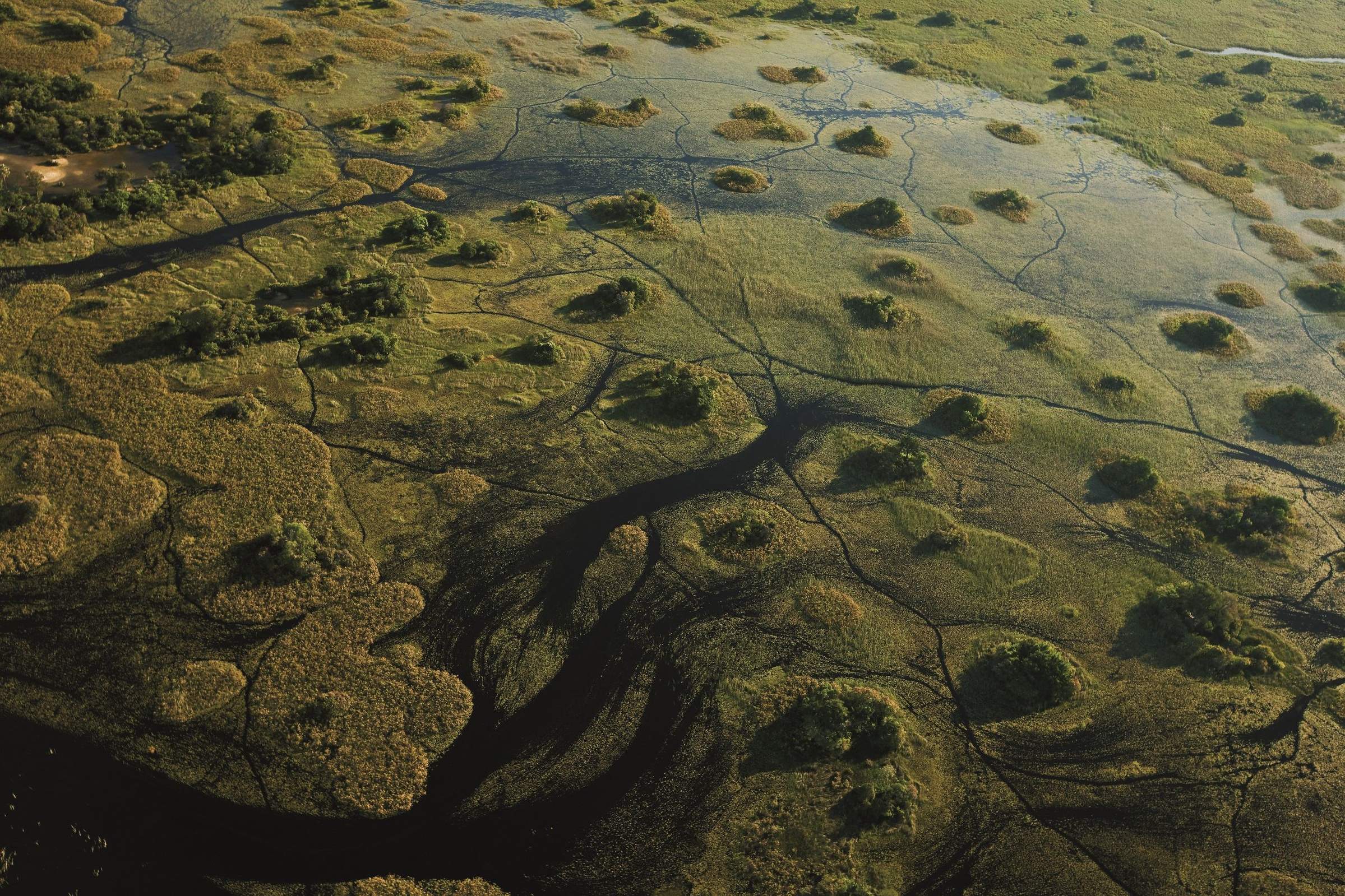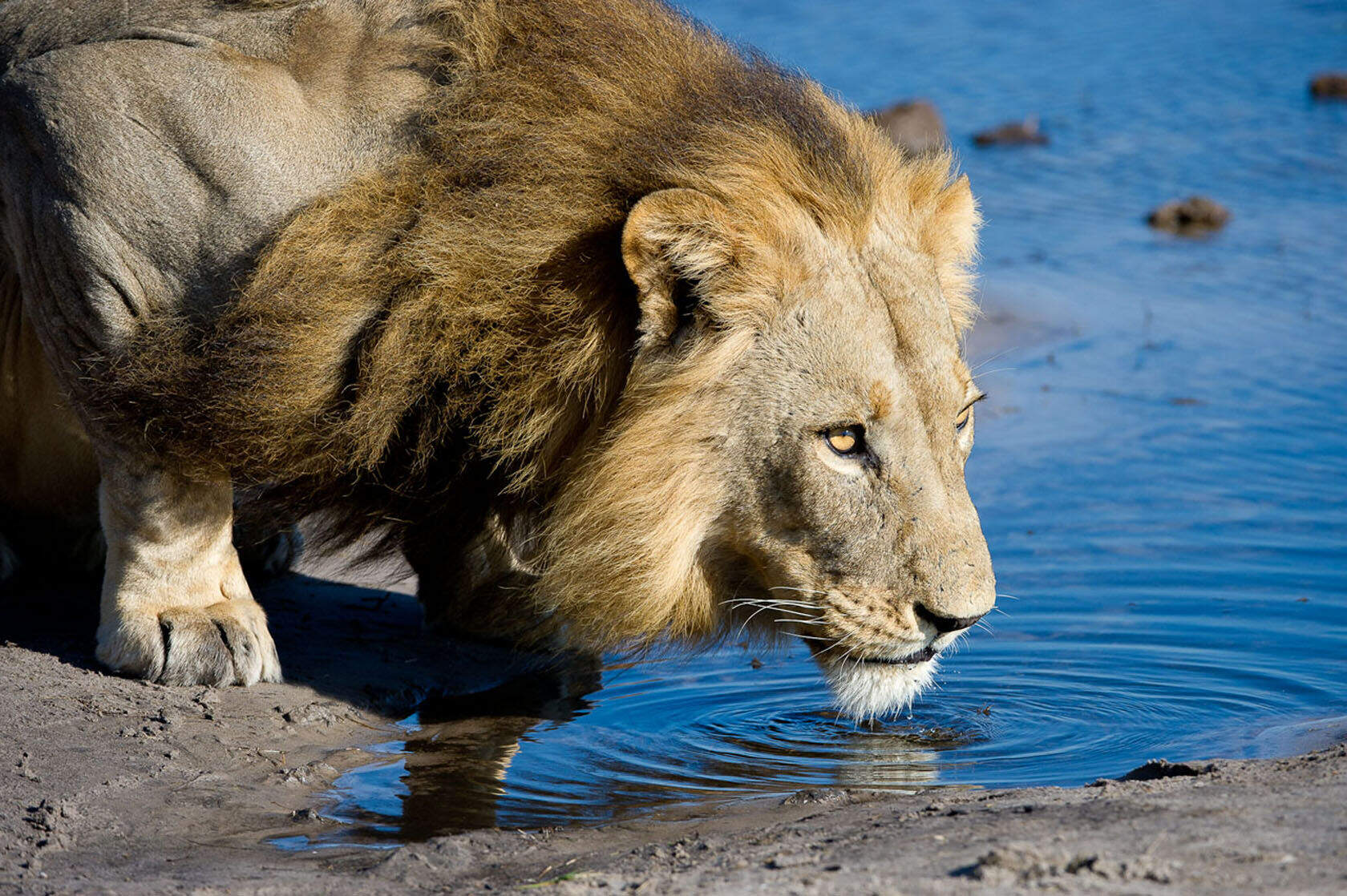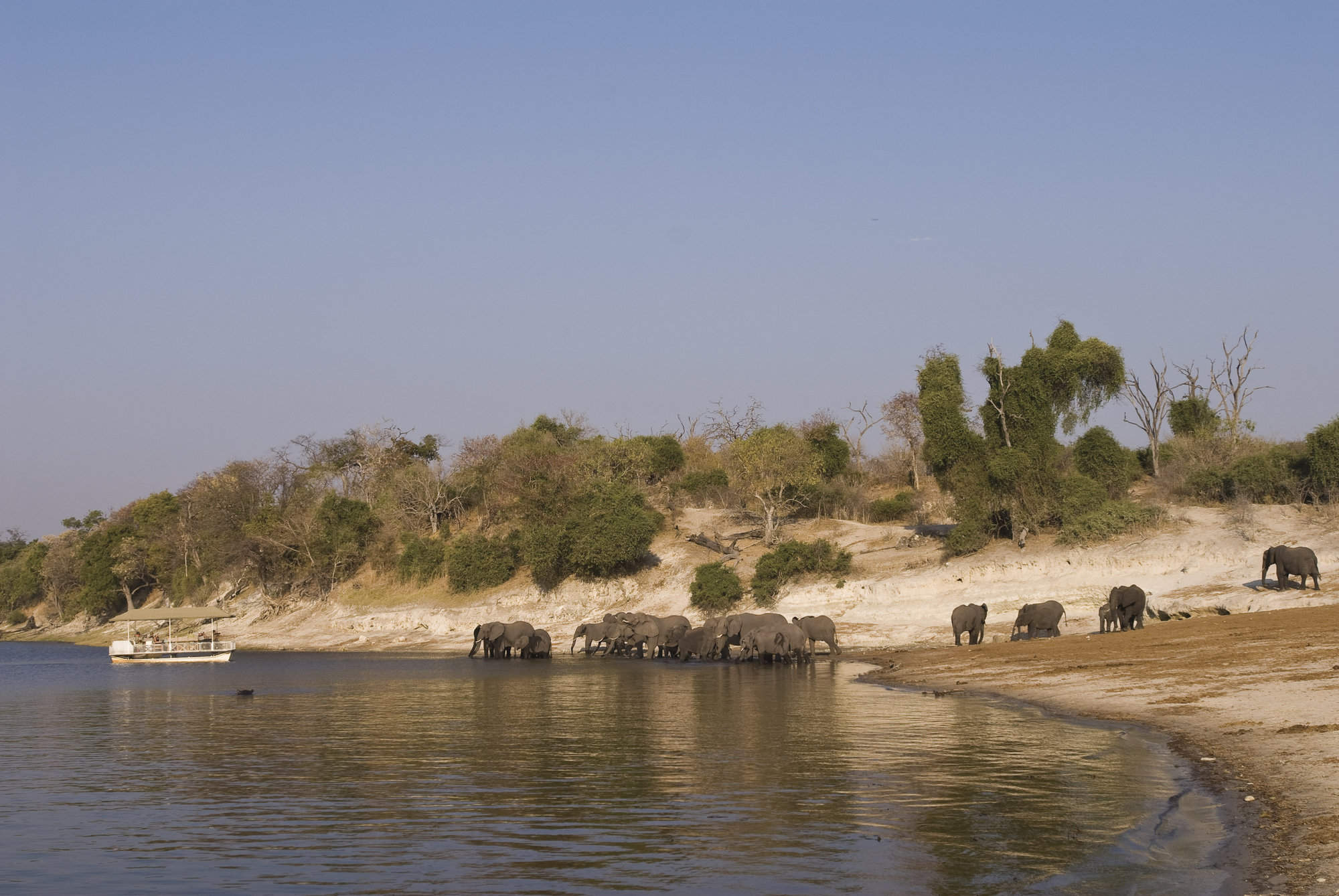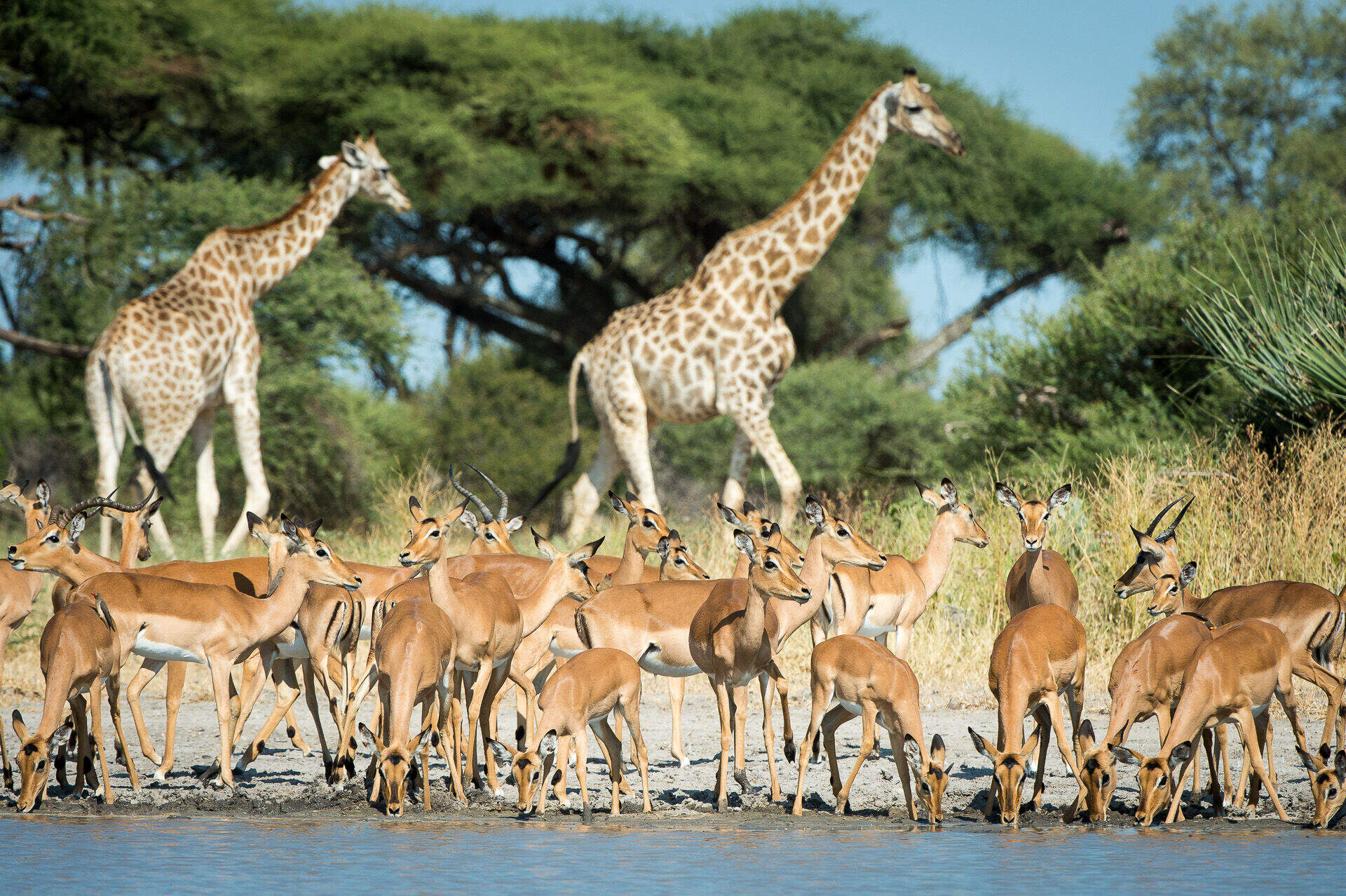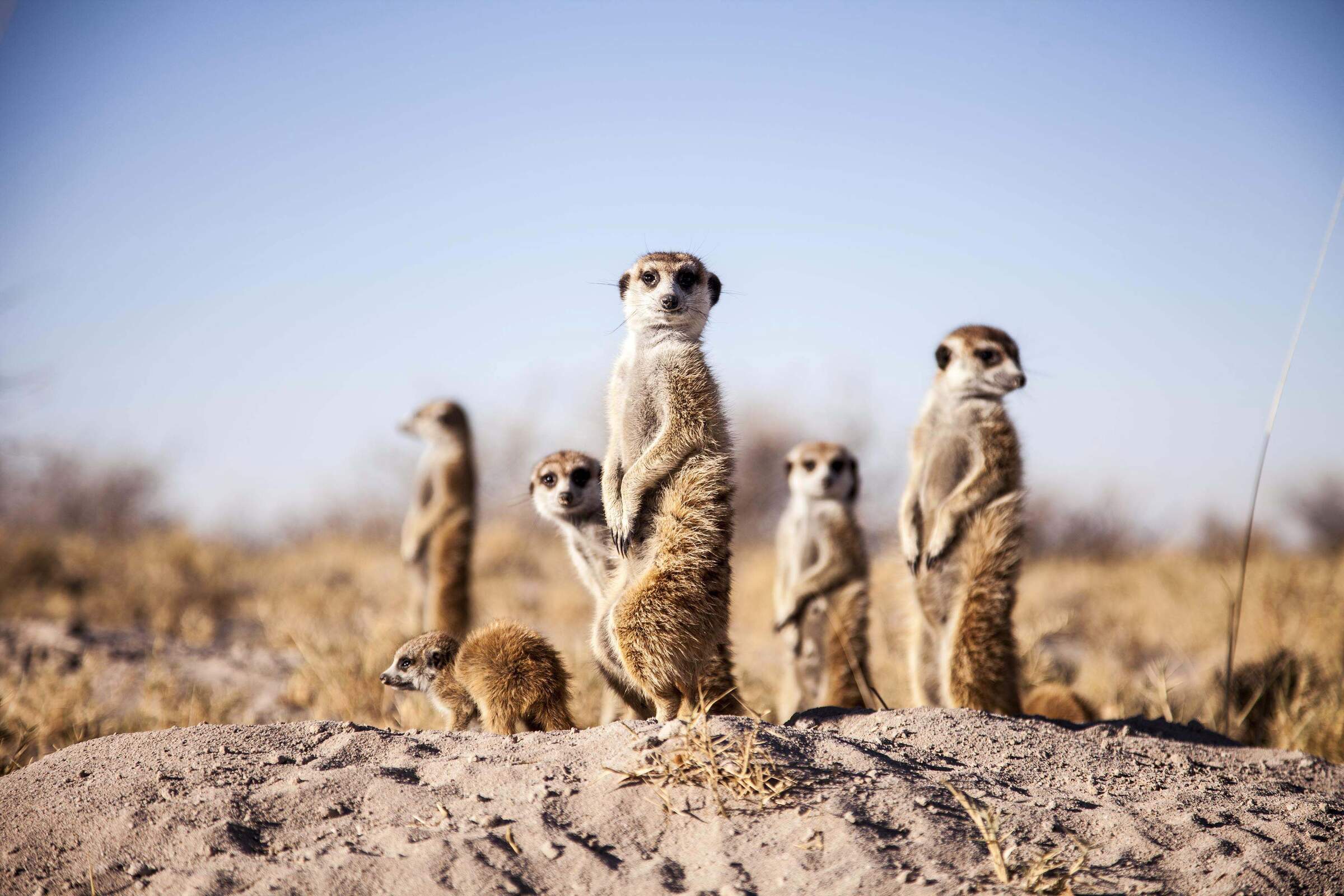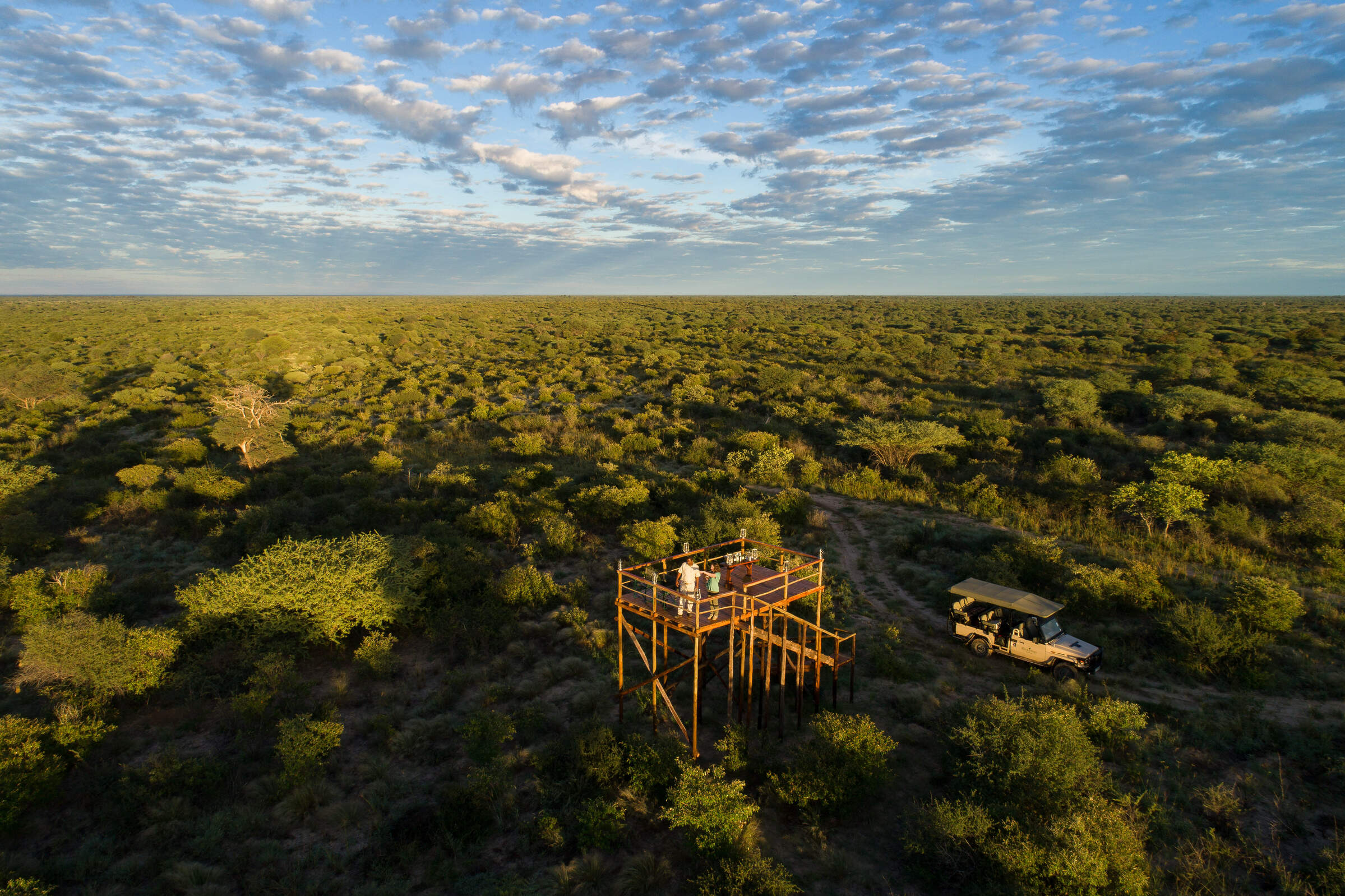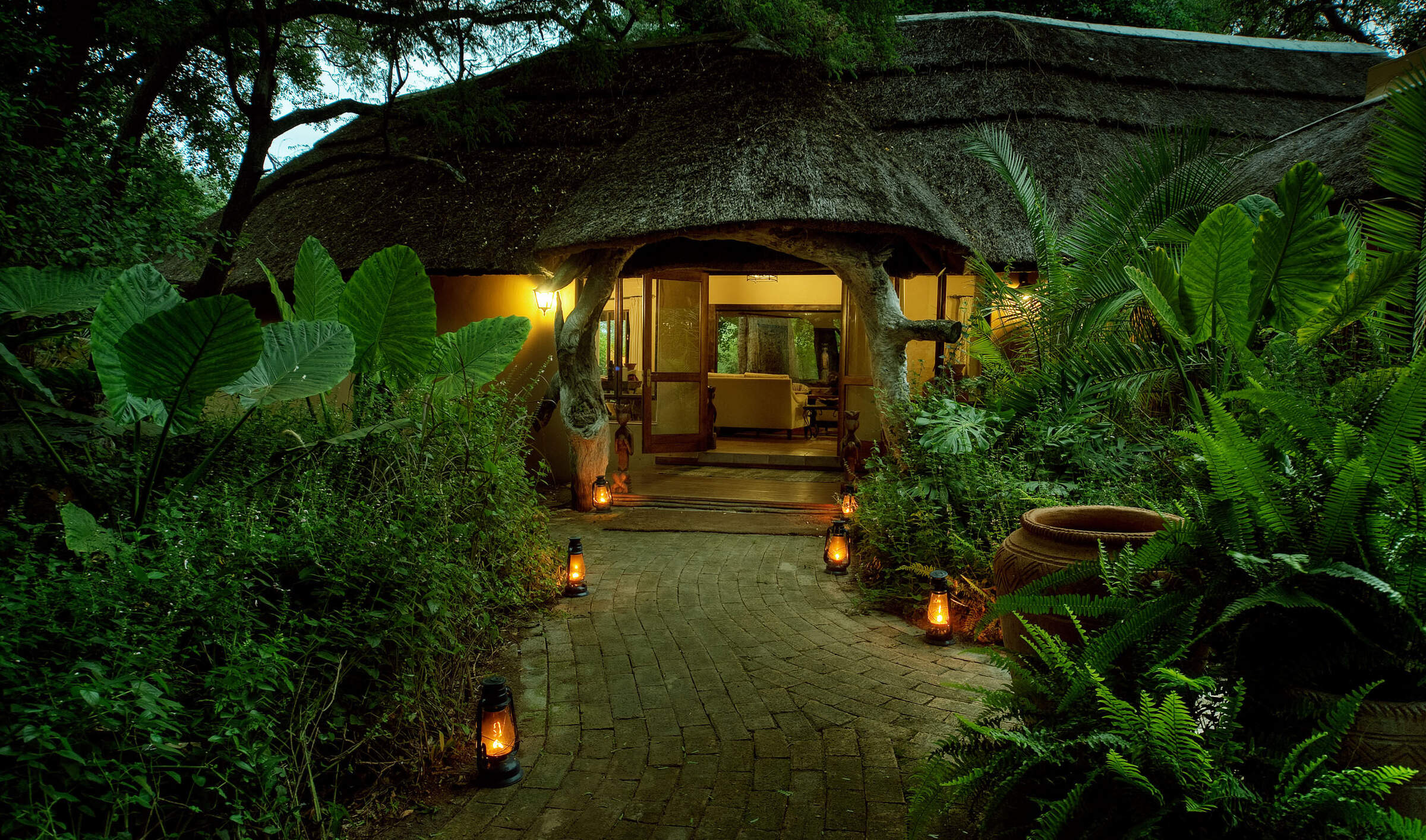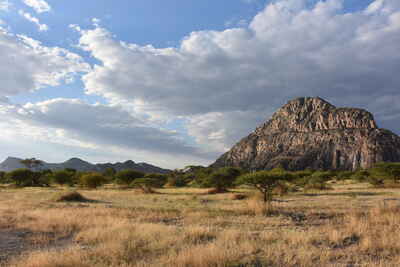
Tsodilo Hills may seem remote and inaccessible…
The Panhandle, first class bird watching.
…but they offer spectacular views from the top.
The region's nickname ‘the Louvre of the desert’.
North-west Kalahari & Panhandle
North-west Kalahari & Panhandle
Where the desert meets the Delta: a land of legends, wildlife, and untamed adventure.
In Botswana’s remote north-west, the wild expanse of the Kalahari collides with the life-giving waters of the Okavango River, creating a landscape of striking contrasts and unforgettable experiences.
The Okavango Panhandle, a vital artery of the Delta, carves its way through reed-lined channels, where houseboats drift serenely, fishermen cast their lines, and mokoros glide past hippos basking in the shallows. This is where birdwatchers delight in myriad species, while wildlife enthusiasts spy elusive sitatunga and crocodiles lurking in the papyrus swamps.
Journeying west, the wilderness deepens, giving way to ancient secrets hidden within the rugged outcrops of the Tsodilo Hills. Rising abruptly from the surrounding plains, these UNESCO-listed spiritual monoliths hold over 4,000 rock paintings – silent testaments to human history spanning more than 60,000 years. For the San people, the Tsodilo Hills are sacred, a realm where spirits whisper through the wind, and every rock tells a story of the past. Every visitor will tell you that it really is a very special place.
Beyond, the vastness of the North-west Kalahari offers an untouched frontier for intrepid explorers. The solitude of the Gcwihaba Caves and the remote Aha Hills beckon those willing to venture off the beaten path, where star-filled skies stretch endlessly over golden dunes and fossilised riverbeds.
Whether navigating the winding waters of the Panhandle, hiking among ancient rock art, or losing yourself in the silent majesty of the desert, this is a place where adventure is still raw, nature still reigns, and every journey becomes a story worth telling.

North-west Kalahari & Okavango Panhandle
The Okavango Panhandle, Tsodillo Hills, Gcwihaba Caves and Aha Hills
Stretching across three countries and 930,000km2 the sand-covered plain of the Kalahari Desert is enormous.
To the west, its reddish sands merge with those of the Namib in an uninterrupted sand sea, halted only by the Atlantic Ocean; to the south the sands give way to the mountain ranges of the Cape as the climate changes; and to the north and east the hills and rivers of Angola, Zambia and Zimbabwe give rise to a more verdant landscape.
Given its vast size and variety, it is impossible to address the Kalahari in its entirety in just one section of our website. So we break it down into more manageable chunks, including the Central Kalahari Game Reserve, the Kalahari's Salt Pans and the Okavango Delta, and this section on the North-west Kalahari and Panhandle.
Compared with some of the more well-known areas of the Kalahari, the north-western region may seem remote, inaccessible and empty. However, there are some truly special places, which can be incredibly rewarding for those willing to make the effort to reach them.
The Okavango Panhandle
However, the birdwatching in this area is also first class, with rarities such as African skimmers and Pel's fishing owls as well as a host of egrets, storks, kingfishers and warblers. These camps offer a good-value Okavango experience, especially if you are driving on the west side of the Delta, perhaps as an extension of a trip down Namibia's Caprivi Strip.
Tsodilo Hills
It’s a magnificent and magical sight that needs to be experienced before you can begin to understand its significance. Archaeologists have found evidence of human activity here dating back at least 100,000 years, and the area remains a place of significant cultural importance for the San people who call this region home. Perhaps it is this rapidly changing living link to our ancestors that makes the whole area so intriguing.
The area is best visited on a superb day trip from Nxamaseri Lodge or as a part of a private mobile safari; contact us for details.
Gcwihaba Caves and Aha Hills
Gcwihaba, which translates as "hyena's hole", is Botswana’s only known major cave network. Linking two separate entrances is a system of passageways and chambers that form a walkable route of approximately 1km long, albeit with many dead ends. Given the size and remoteness of the caves we suggest exploring them only with a local San guide, which should prevent you getting lost.
Straddling the Namibia–Botswana border, the Aha Hills are the smaller, more rugged cousins of those at Tsodilo. Their isolation and existence draw in the intrepid, though there is seemingly little else to detain visitors. That said, there are a couple of impressive sinkholes – albeit very difficult to find – and this is one of a few areas where travellers can arrange to see a San Bushman trance dance. Given the remoteness of these areas it is really only possible to visit as a part of a private guided trip, or whilst staying at the superb and intriguing The Lodge at Feline Fields.
North-west Kalahari & Okavango Panhandle Safaris
The Okavango Panhandle and North-West Kalahari offer an extraordinary blend of water and desert safaris. The Panhandle’s winding channels provide a serene setting for boat and mokoro trips, birdwatching, and fishing, while the Tsodilo Hills reveal ancient rock art and deep cultural history. Beyond the wetlands, the vast Kalahari opens up with fossilised riverbeds, rolling dunes, and hidden caves.
These areas combine seamlessly with Namibia’s wildlife-rich Caprivi Strip, the dramatic landscapes of Etosha, and elephant-rich riverside of Chobe National Park. Whether by boat, vehicle, or foot, pairing the Panhandle’s waterways with the rugged Kalahari makes for an epic safari.
Check out some excellent holidays here or contact our Botswana Experts to discuss your own tailor-made trip.
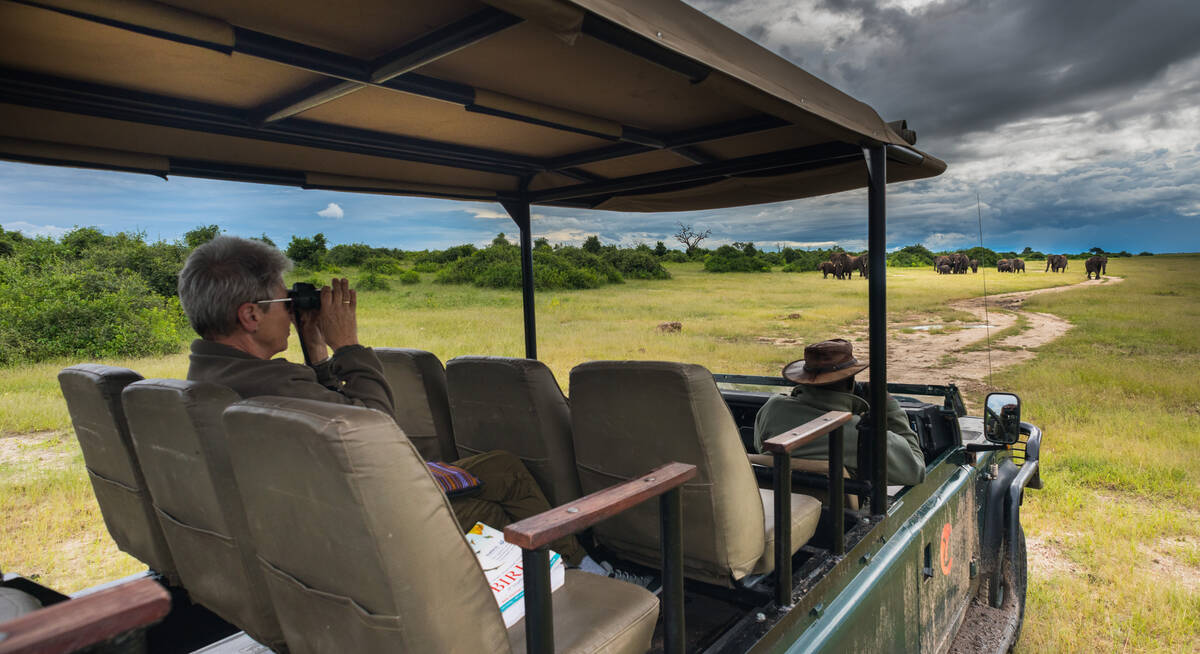
Pygmy Mouse Self-drive Safari
18 days • 10 locations
WINDHOEK AIRPORT TO VICTORIA FALLS AIRPORT
A truly epic southern African self-drive safari adventure from Namibia’s mountains and deserts, along the lush Caprivi Strip to Botswana and Victoria Falls in Zimbabwe, staying at luxury lodges throughout.
US$8,720 - US$10,430 per person
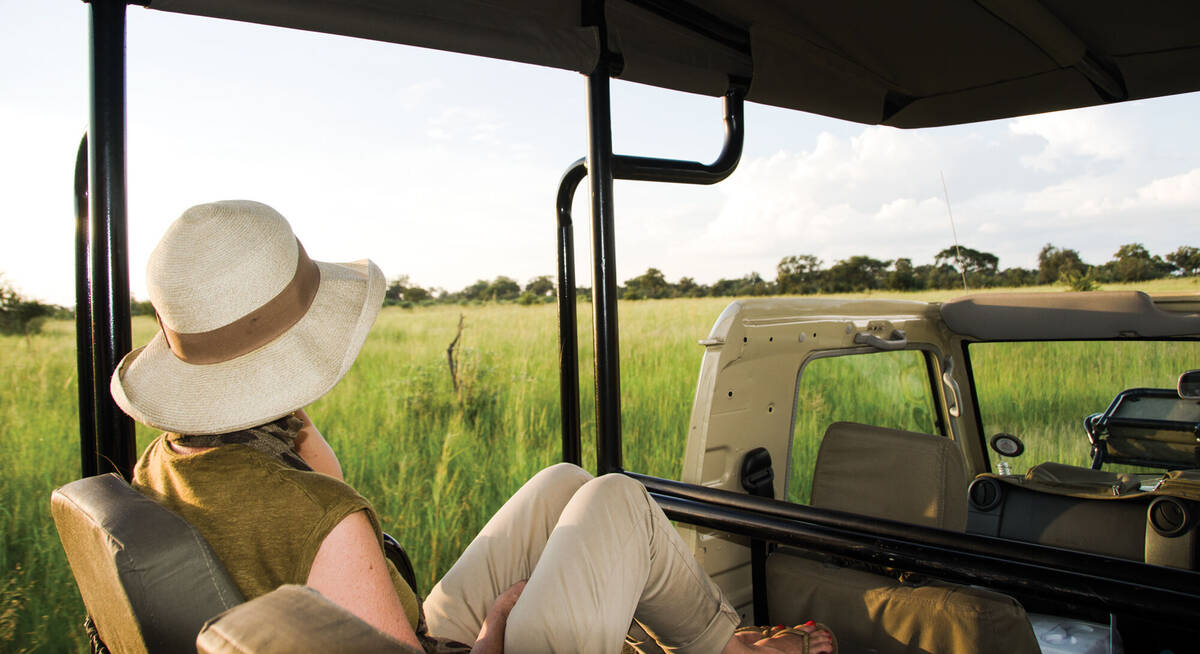
Rock Hare Self-drive Safari
20 days • 12 locations
WINDHOEK AIRPORT TO VICTORIA FALLS AIRPORT
An in-depth look at Namibia from the Namib Desert to the Caprivi, with additional stops in Botswana and Victoria Falls. This three-week adventure includes an unrivalled mix of environments and is great value.
US$7,400 - US$8,360 per person
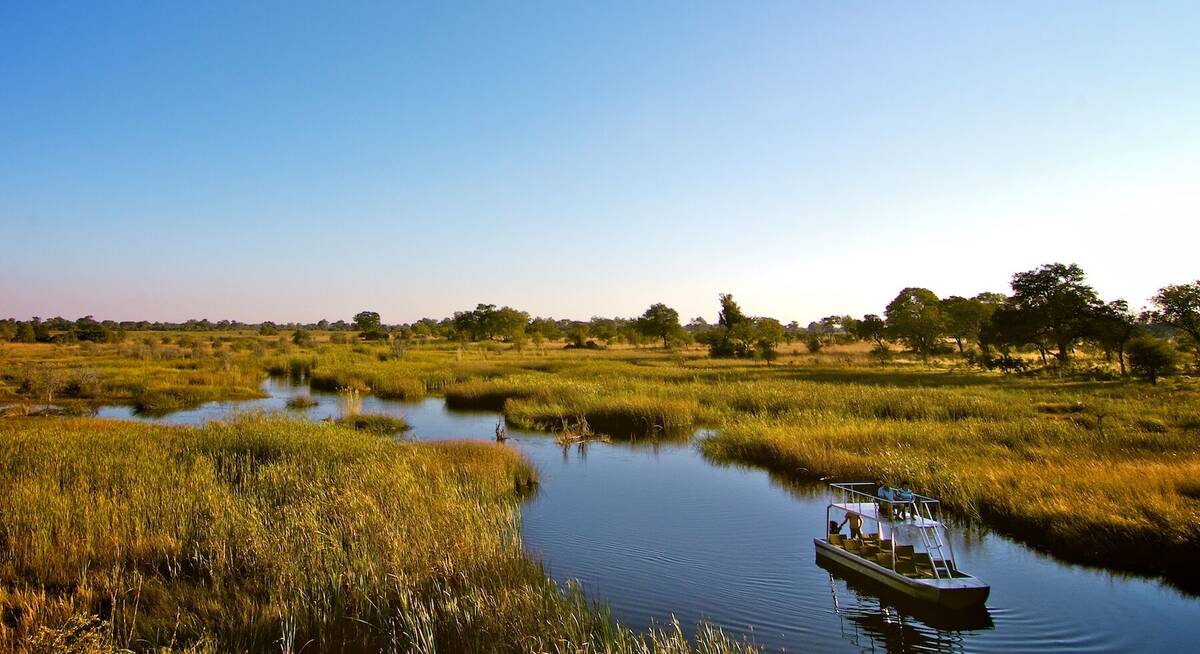
Sable Self-drive Safari
12 days • 7 locations
WINDHOEK AIRPORT TO VICTORIA FALLS AIRPORT
A great-value southern African self-drive adventure from Namibia along the Caprivi Strip to Botswana and Zimbabwe, combining other-worldly landscapes, unforgettable wildlife spectacles and rarely visited places, and ending at Victoria Falls.
US$8,390 - US$9,300 per person
Reviews of our North-west Kalahari & Okavango Panhandle Safaris
Our travellers have shared their firsthand experiences of exploring the Okavango Panhandle and North-West Kalahari, offering genuine insights into safaris in this remote region.
From the serene mokoro journeys through the Panhandle’s papyrus-lined waterways to the awe-inspiring San rock art at Tsodilo Hills, their reviews highlight the region’s unique blend of culture, wildlife, and adventure. Others recount the thrill of tracking game in the Kalahari’s vast landscapes, where desert-adapted species roam under endless skies.
Read the unedited traveller reviews to see what makes this area so special, then let us design a tailor-made safari here for you.
Arrived 5 Sep 2024, 18 nights
"My Sep 2024 trip"
Overall rating: Excellent
Arrived 24 Aug 2024, 14 nights
"Our Aug 2024 trip - Panhandle, Moremi, Savuti and "
Overall rating: Excellent
Arrived 23 Jun 2023, 15 nights
"My Jun 2023 trip"
Overall rating: Excellent
Arrived 11 May 2023, 22 nights
"My May 2023 trip"
Overall rating: Excellent
Arrived 15 Jan 2023, 15 nights
"My Jan 2023 trip"
Overall rating: Excellent
Arrived 24 Nov 2022, 20 nights
"Namibia, Botswana and Vic Falls Trip"
Overall rating: Excellent
Arrived 21 Jul 2022, 19 nights
"My Jul 2022 trip"
Overall rating: Excellent
Arrived 18 May 2022, 22 nights
"My May 2022 trip"
Overall rating: Excellent
Arrived 13 May 2022, 21 nights
"My May 2022 trip"
Overall rating: Excellent
Arrived 27 Jul 2019, 29 nights
"Third time with Expert Africa, still happy"
Overall rating: Excellent
The best camps in North-west Kalahari & Okavango Panhandle
This region offers a trio of excellent camps, each providing a unique safari experience in Botswana’s untouched north-west wilderness.
For an immersive river-based stay, Nxamaseri Lodge offers superb fishing and birdwatching from its beautiful island setting in the Okavango Panhandle. In a remote corner of the rolling Kalahari, Feline Fields provides a luxurious retreat, allowing guests to explore a seldom-visited part of Botswana. For a cultural experience, the Tsodilo Hills Sleep-Out Camp offers an immersive overnight stay within walking distance of ancient rock art sites, providing insight into the region's rich heritage.
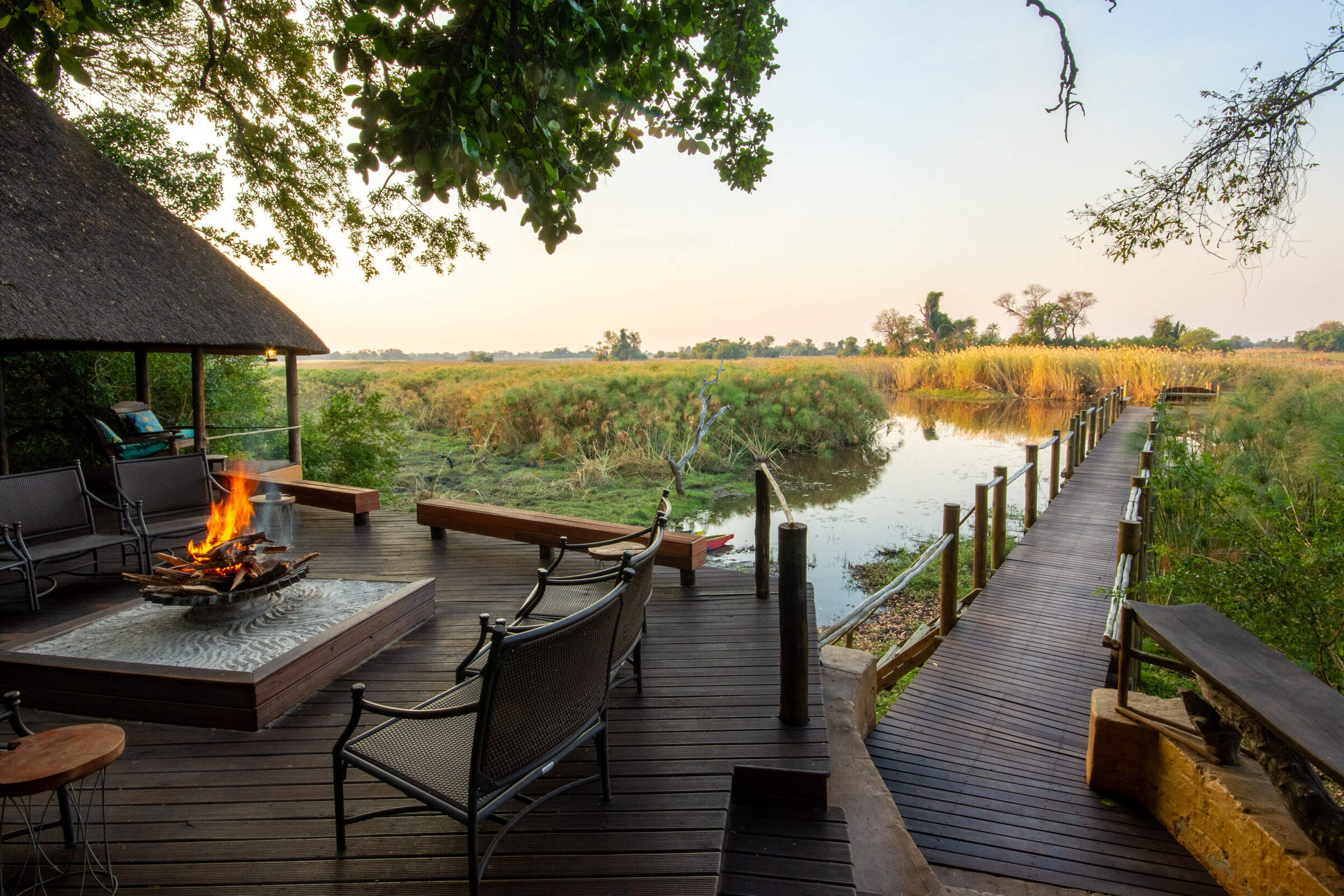
Nxamaseri Lodge
From its beautiful island setting, Nxamaseri Lodge offers superb fishing and birdwatching in a relatively affordable area of the Okavango.
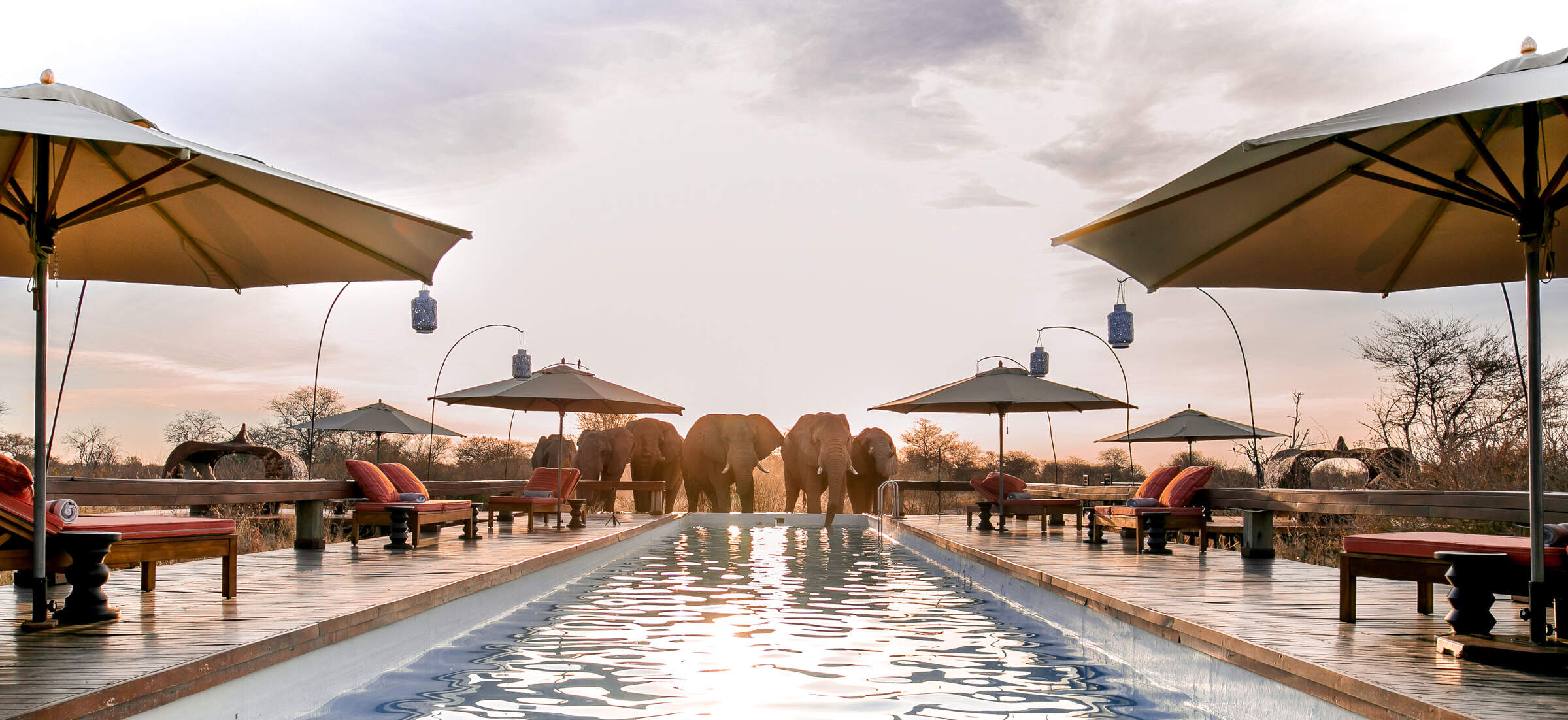
Feline Fields
In a remote corner of the Kalahari, Feline Fields offers guests a luxurious stay in a seldom-visited part of Botswana.
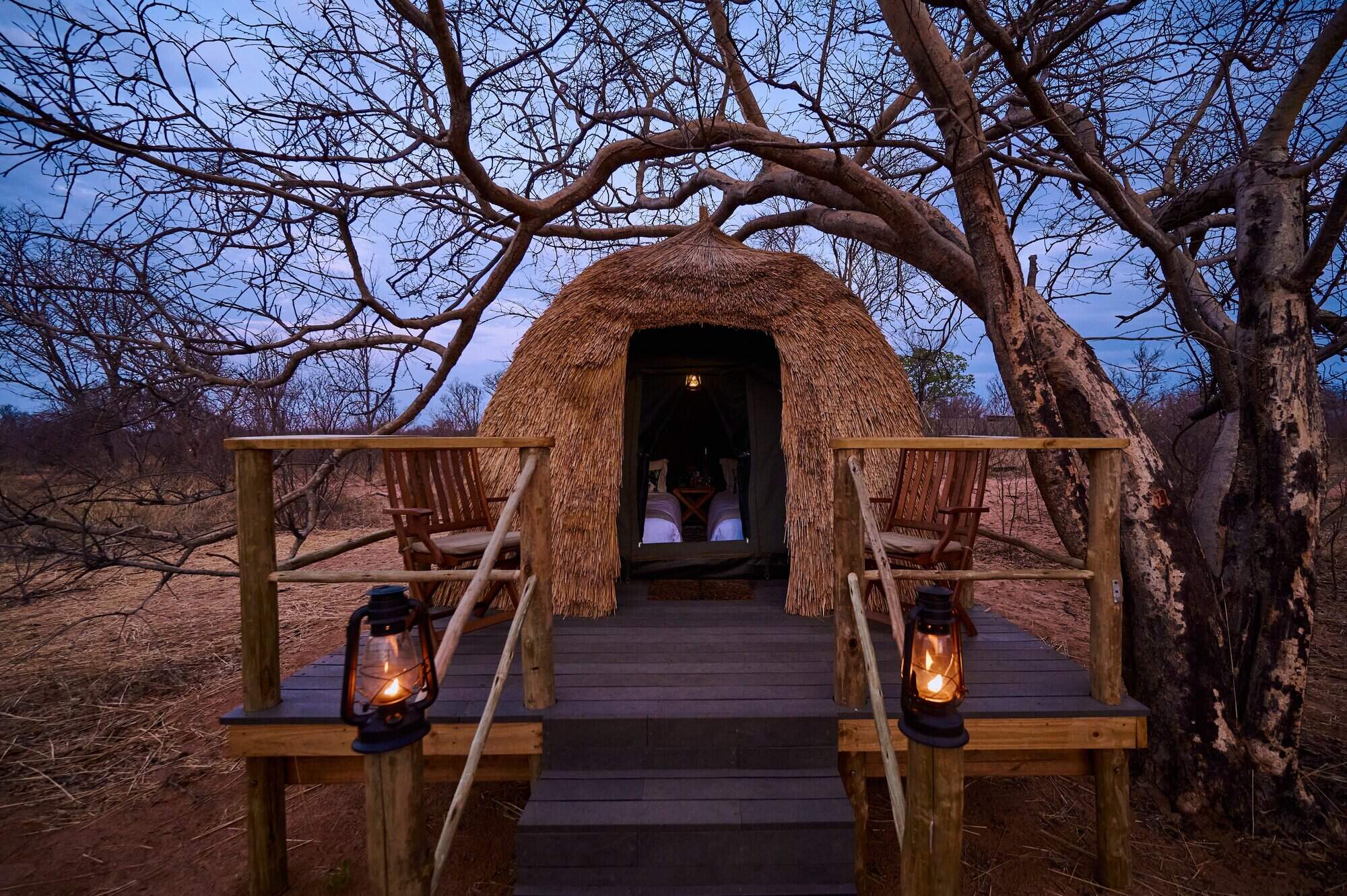
Tsodilo Sleep-Out
Within walking distance of the region’s ancient rock art, the Tsodilo Hills Sleep-out Camp is an immersive overnight experience for guests at Nxamaseri Island Lodge.
Wildlife in the North-west Kalahari & Okavango Panhandle
The North-west Kalahari and Okavango Panhandle offer a striking contrast of landscapes. The vast, arid Kalahari stretches across rolling dunes and fossil river valleys, while the Panhandle’s lush, reed-lined waterways form a lifeline for wildlife. In the wet season, the Tsodilo Hills and surrounding valleys come alive as fresh grasses attract herds of springbok and oryx. The Panhandle’s waterways, meanwhile, teem with hippos, crocodiles, and spectacular birdlife.
Our ongoing wildlife tracking project, based on Expert Africa traveller reports, has logged sightings in this remote region since 2018. The most commonly seen species include red lechwe, sitatunga, elephants, bat-eared foxes, and brown hyenas. Big cats remain present year-round, though sightings peak in the green season.
Click on an animal below for the latest traveller-reported sightings. How we work this out.

87% success

38% success

11% success

0% success

0% success

0% success

0% success

0% success

0% success

0% success
The best time to visit the North-west Kalahari & Okavango Panhandle
The Okavango Panhandle and North-west Kalahari have two distinct seasons, each offering unique safari experiences.
From November to April, the green season transforms the landscape with dramatic thunderstorms, lush vegetation, and abundant water. This is the best time for birdwatching, as migratory species arrive in large numbers. The flooded channels provide excellent opportunities for mokoro safaris and fishing, while the Tsodilo Hills are particularly striking against the verdant backdrop.
The dry season (May–October) brings cooler temperatures, clear skies, and peak wildlife viewing, as animals concentrate around permanent water sources. Fishing is at its best during this time, especially in September when the barbel run attracts large tigerfish. If you like walking, Tsodilo Hills offers crisp, clear conditions, perfect for exploring the region’s ancient rock art and stunning landscapes
Jan
Feb
Mar
Apr
May
Jun
Jul
Aug
Sep
Oct
Nov
Dec
North-west Kalahari & Panhandle in January
The Okavango Panhandle is at the height of its rainy season, with short but intense evening showers creating a lush and vibrant landscape. Nxamaseri Lodge offers outstanding birding opportunities, as migratory species begin to arrive in large numbers. The swelling Okavango River provides perfect conditions for boat safaris, showcasing the area’s unique ecosystems. Fishing in the Panhandle picks up as water levels rise, attracting keen anglers.
At Tsodilo Hills, the rock art becomes more vivid against the green backdrop. Despite the rains, this UNESCO World Heritage Site remains accessible, offering a unique mix of natural beauty and cultural history. Rain-filled rock pools reflect the ancient rock paintings, adding an enchanting dimension to the experience.
In the Kalahari Desert, Feline Fields presents a more dispersed wildlife experience due to the abundance of water, but the vast landscape is breathtaking.
- Warm days with occasional thunderstorms
- Spectacular birdlife with migratory species arriving
- Rising water levels ideal for boat safaris
- Tsodilo Hills accessible but prepare for rain
- Low visitor numbers and good lodge availability
Our view
A good time to visit, with pros & cons
Weather in January
North-west Kalahari & Panhandle in February
Heavy rains continue in the Okavango Panhandle, sustaining the lush and vibrant landscapes. At Tsodilo Hills, the hiking trails may become slippery, but the vivid rock art framed by verdant backdrops makes it worthwhile. Water-based activities at Nxamaseri Lodge are at their peak, with mokoro trips offering intimate views of the Delta’s beauty. Fishing remains excellent due to the high water levels in the Okavango River.
Feline Fields provides a striking contrast between the water-abundant Delta and the arid Kalahari. Birdwatching throughout the region is exceptional, with many species nesting and breeding. The Panhandle’s lagoons and channels teem with life, creating unique photographic opportunities. Cultural experiences with local communities near Tsodilo Hills offer fascinating insights into traditional practices during the wet season.
- Warm days with frequent thunderstorms
- Birdlife at its peak, ideal for bird enthusiasts
- Mokoro and fishing activities thriving
- Tsodilo Hills rock art vivid after rainfall
- Low-season rates available at Kalahari camps and lodges
Our view
This is not a great time to visit
Weather in February
North-west Kalahari & Panhandle in March
The rainy season begins to taper off, and clear days become more common in the Okavango Panhandle. Drying hiking trails make Tsodilo Hills’ ancient rock art sites more accessible. Nxamaseri Lodge sees increased wildlife activity as animals re-emerge. The receding Okavango River concentrates fish, attracting predators and enhancing fishing opportunities.
The Panhandle remains lush, with birds and wildlife still raising their young. Fishing for tigerfish is especially productive. As the rains diminish, guided tours at Tsodilo Hills provide easier access and deeper insights into the region’s cultural significance.
- Warm temperatures with occasional rains
- Excellent conditions for Tsodilo Hills exploration
- High Panhandle waters perfect for mokoro safaris
- Birdlife still abundant, fishing opportunities improving
- Fewer visitors and favourable rates at lodges
Our view
A good time to visit, with pros & cons
Weather in March
North-west Kalahari & Panhandle in April
April marks a transitional period in the Okavango Panhandle as the rains subside. Tsodilo Hills offers perfect hiking conditions with cooler evenings and dry trails. Water activities at Nxamaseri Lodge benefit from calmer waters and increased animal sightings. The stabilising Okavango River provides excellent opportunities for both boating and fishing.
Game viewing improves at Feline Fields as vegetation thins, making wildlife easier to spot. Birdlife remains diverse, with some migratory species still present. As surface water dries up, animals congregate around permanent water sources. The vivid contrast of Tsodilo Hills’ rock art against the drying landscape is striking. Cultural visits to San communities near Tsodilo Hills reveal traditional practices during this seasonal shift.
- Cooler evenings with occasional showers
- Mokoro trips at their best and good fishing
- Tsodilo Hills trails ideal for hiking
- Increased wildlife visibility in the Panhandle
- Shoulder season begins with favourable rates
Our view
A good time to visit, with pros & cons
Weather in April
North-west Kalahari & Panhandle in May
The dry season begins, bringing cool mornings and evenings to the Okavango Panhandle. Tsodilo Hills becomes a haven for hikers and rock art enthusiasts, with excellent conditions. Nxamaseri Lodge offers exceptional fishing opportunities as water levels drop and fish concentrate. Wildlife along the Okavango River becomes easier to spot as animals gather at its banks.
The drying landscape at Feline Fields enhances predator sightings, as hunting conditions improve. Birdwatching remains rewarding, particularly in shrinking wetlands. Mokoro trips in shallower waters allow for close encounters with Delta wildlife. The arrival of Angola’s floodwaters in the northern Delta signals a unique ecological transition.
- Cool mornings, low chance of rain
- Water-based activities thriving in the Panhandle
- Ideal rock art viewing conditions at Tsodilo Hills
- Excellent fishing opportunities, particularly for tigerfish
- Shoulder season rates available
Our view
A very good time to visit
Weather in May
North-west Kalahari & Panhandle in June
The Okavango Panhandle experiences cool, dry conditions. The clear winter light beautifully highlights Tsodilo Hills’ rock art, making it an ideal time for exploring this cultural treasure. Nxamaseri Lodge offers outstanding game viewing as wildlife congregates around water sources, and the Okavango River attracts a diverse range of animals, creating stunning scenes. Night game drives at Feline Fields take full advantage of the cooler weather.
The thinning vegetation in the Panhandle improves wildlife visibility. Fishing remains productive, particularly for tigerfish, and birdwatching is rewarding with many water birds in view. Mokoro trips offer tranquil Delta experiences, while Tsodilo Hills’ hiking trails provide sweeping views of the surrounding landscape. Visitors can also enjoy cultural exchanges with local communities, gaining insights into traditional winter practices.
- Warm days, cold nights
- Clear skies perfect for stargazing
- Mokoro trips popular for serene wildlife encounters
- Tsodilo Hills hikes comfortable in cool weather
- Peak season begins, with higher rates at lodges
Our view
Fantastic: the very best time to visit
Weather in June
North-west Kalahari & Panhandle in July
The Okavango Panhandle reaches its coolest month, providing perfect conditions for exploring Tsodilo Hills’ rock art and hiking trails. Nxamaseri Lodge offers peak game viewing as wildlife concentrates near dwindling water sources. The Okavango River becomes a vital lifeline, creating dramatic wildlife scenes. Early morning and night game drives at Feline Fields are rewarding but chilly - packing warm clothing is essential.
The dry landscape of the Panhandle enhances wildlife visibility. Fishing is at its peak, especially for tigerfish, while birdwatching remains excellent with large numbers of water birds. Mokoro trips allow for intimate encounters with Delta wildlife, and Tsodilo Hills’ spiritual significance is amplified in the crisp winter air. Local San communities offer cultural insights into traditional survival techniques during the dry season.
- Comfortable days, cold nights
- Excellent fishing for tigerfish in the Panhandle
- Tsodilo rock art vivid in dry conditions
- Wildlife concentrated around water sources
- Peak season - advance booking for lodges is essential
Our view
Fantastic: the very best time to visit
Weather in July
North-west Kalahari & Panhandle in August
The Okavango Panhandle remains dry, with temperatures gradually rising. Tsodilo Hills’ rock art is immaculately preserved in the dry conditions, offering excellent opportunities for photography. Nxamaseri Lodge provides exceptional game viewing and fishing, as animals and fish concentrate around the shrinking water sources. The Okavango River attracts diverse wildlife, creating spectacular photographic moments.
At Feline Fields in the Kalahari, game viewing continues to improve as animals gather near water sources during the late dry season. The Panhandle’s parched landscape offers unobstructed views of wildlife. Birdwatching is rewarding, with species congregating around remaining water bodies. Mokoro trips provide serene experiences, while Tsodilo Hills’ trails showcase panoramic views of the arid surroundings.
- Dry, warm days with cool nights
- Panhandle fishing at its peak
- Tsodilo Hills ideal for photography
- Mokoro trips offer close wildlife encounters
- High season with lodges often fully booked
Our view
Fantastic: the very best time to visit
Weather in August
North-west Kalahari & Panhandle in September
Rising temperatures define September in the Okavango Panhandle. Tsodilo Hills offers warm yet comfortable conditions for exploring its rock art and hiking trails. At Nxamaseri Lodge, game viewing intensifies as animals concentrate around remaining water sources. The Okavango River becomes even more vital for wildlife, offering incredible scenes of activity. At Feline Fields herds gather near the scatted waterpoints in the Kalahari.
The dry landscape in the Panhandle enhances wildlife visibility, while on the water, September marks the start of the barbel run, attracting an array of fish and their predators. Mokoro trips provide close encounters with wildlife in shallow waters and birdwatching is exceptional, with migratory species beginning to arrive. Cultural experiences with local communities provide insights into traditional fishing and hunting techniques during this transitional period.
- Warmer days, cool nights
- Annual barbel run attracts tigerfish
- Tsodilo Hills trails dry and easily navigable
- Excellent birdwatching with returning migratory birds
- Peak season continues, advance booking essential
Our view
Fantastic: the very best time to visit
Weather in September
North-west Kalahari & Panhandle in October
October is the hottest month in the Okavango Panhandle, with Tsodilo Hills’ rock art and panoramic hiking trails best viewed in the early mornings or late afternoons. Nxamaseri Lodge continues to offer excellent game viewing near the remaining water sources. The Okavango River supports diverse wildlife, creating dramatic scenes as October also sees the peak of the barbel run. Birdwatching is at its prime with numerous migratory species arriving. Mokoro trips in shallow waters provide unique and intimate wildlife encounters.
At Feline Fields, the Kalahari’s stark, arid landscape offers unobstructed wildlife viewing. Cultural experiences with local communities offer insights into traditional practices for surviving this hottest period of the year.
- Hot days, chance of rain late in month
- Last chance for Panhandle fishing season
- Tsodilo Hills hot but rewarding for rock art
- Water levels low, affecting some activities
- Final month of peak season at most lodges
Our view
Fantastic: the very best time to visit
Weather in October
North-west Kalahari & Panhandle in November
November brings the beginning of the rains and the green season to the Okavango Panhandle. Tsodilo Hills’ rock art becomes even more striking against the greening landscape. At Nxamaseri Lodge, wildlife begins to disperse as new water sources emerge, shifting the dynamics of game viewing. The Okavango River’s rising levels signal the start of the Delta’s transformation.
The first rains breathe life into the Kalahari at Feline Fields, with the arid landscape turning green. The Panhandle’s ecosystem also begins to flourish, while fishing remains productive as the barbel run concludes. Birdwatching is outstanding, with both resident and migratory species present. Mokoro trips offer unique perspectives of the changing landscape. Cultural interactions at Tsodilo Hills include rain-welcoming ceremonies that celebrate the renewal of the land.
- Hot days, increasing chances of rain
- Water levels rising in the Panhandle
- Tsodilo Hills best explored in early morning
- Migrant birds arrive, excellent birdwatching opportunities
- Shoulder season begins, offering lower rates
Our view
A good time to visit, with pros & cons
Weather in November
North-west Kalahari & Panhandle in December
The Okavango Panhandle is in full rainy season. The swelling Okavango River revitalises the Delta region, transforming the landscape into a vibrant, green paradise, criss-crossed with newly formed channels and lagoons, and teeming with new life. Mokoro trips navigate through newly flooded plains, and Nxamaseri Lodge offers unique wet-season safaris, with boat trips navigating fresh waterways. Birdwatching is exceptional with numerous breeding birds, and fishing is challenging but rewarding in the high waters.
Feline Fields provides contrasting experiences between the water-rich Delta and the greening Kalahari. At Tsodilo Hills, the rock art is framed by lush vegetation, creating stunning contrasts, and the hiking trails offer stunning views of the transformed landscape. Cultural experiences with local communities near Tsodilo Hills provide insights into traditional wet season activities and storytelling.
- Warm days with increasing rainfall
- Rising waters in the Panhandle enable unique boat safaris
- Tsodilo Hills lush - prepare for wet conditions
- Green season begins, transforming the landscape
- Low season rates make December attractive for visitors
Our view
A good time to visit, with pros & cons
Weather in December
North-west Kalahari & Panhandle: In detail
Exploring North-west Kalahari, Tsodilo Hills & Okavango Panhandle – Wildlife & Experiences
Planning a safari to the North-West Kalahari and Okavango Panhandle raises many questions, from what wildlife to expect to the best ways to explore this remote region. This section covers key details to help you make the most of your journey.
Discover the contrast between the desert and waterways, with information on wildlife sightings, birdwatching hotspots, and cultural encounters at Tsodilo Hills. Learn about mokoro safaris, fishing excursions, and excellent guided walks with the San people.
Whether you're flying in for a luxury retreat, self-driving from Namibia, or combining this area with Moremi or Chobe, our FAQs provide expert insight to help you plan the perfect adventure.
What animals can I expect to see in the North-west Kalahari and Panhandle?
In the North-west Kalahari, animals have adapted to arid conditions, with species such as oryx (gemsbok), springbok, kudu, and steenbok commonly seen. Predators, though less frequently encountered, include leopards, brown hyenas, and the elusive black-maned Kalahari lions. Small carnivores such as bat-eared foxes and African wildcats are also present.
In the Okavango Panhandle, the permanent waterways sustain a different set of species. Hippos and crocodiles are abundant, while red lechwe can be spotted wading through the floodplains. The region is one of the best places to see sitatunga, a secretive and highly adapted swamp-dwelling antelope. While large predators are scarce, smaller species such as otters and servals thrive in this wetland environment.
What are the best locations for birdwatching in the Panhandle?
- Nxamaseri Island Lodge: Nestled along the Okavango Panhandle, Nxamaseri Island Lodge is a haven for birdwatchers. The surrounding papyrus-lined channels and exposed sandbanks create ideal conditions for species such as the African Skimmer, Pel’s Fishing Owl, and Wattled Crane.
Guided boat trips and nature walks provide intimate encounters with the region's diverse birdlife. - Shakawe Riverfront: Located near the village of Shakawe, this area is renowned for its vibrant bird population. Species commonly observed include various kingfishers, bee-eaters, and reed cormorants. Notably, from September to December, the riverbanks become nesting grounds for colonies of carmine Bee-eaters, offering a spectacular visual display.
- Guma Lagoon: This tranquil lagoon provides excellent opportunities to observe waterfowl and wading birds. Birders can expect to see African Jacanas, Pygmy Geese, and a variety of herons and egrets. The serene environment allows for leisurely birdwatching experiences, either by boat or on foot.
- The Red Cliffs: Situated along the river, these striking cliffs are a seasonal haven for Carmine Bee-eaters. During their breeding season, typically from September to December, thousands of these brightly coloured birds can be seen nesting in the cliff faces, creating a vibrant spectacle.
- Riverine Woodlands: The lush forests adjacent to the waterways support a variety of bird species, including raptors such as the Bateleur Eagle and Martial Eagle. Additionally, these woodlands are home to numerous weaver species, whose intricate nests can be observed hanging from tree branches.
What is special about the Tsodilo Hills, and what can I see there?
According to San folklore, the hills are sacred, believed to be home to the spirits of the dead and powerful gods who reside in caves within the Female Hill. Local Hambukushu traditions claim that humans were lowered to Earth here by God, with footprints in the rock offering supposed proof.
Visitors can explore several marked trails, such as the Rhino Trail and Lion Trail, leading to key rock art panels depicting wildlife, trance dance figures, and geometric patterns. The hills also provide panoramic views over the Kalahari, making them a striking and deeply atmospheric destination.
Are guided cultural experiences or interactions with the San people available?
In the Aha Hills, Xai Xai, and Gcwihaba Caves region, visitors can arrange to explore with a San guide or, on extended stays, possibly witness a traditional trance dance, an important spiritual ritual in San culture. Some experiences also include visits to San villages, where travellers can observe traditional crafts, bushcraft demonstrations, and the use of medicinal plants.
While these experiences are available at select lodges, such as Feline Fields, they are not large-scale, polished tourist performances – which helps preserve authenticity and respect for the San’s way of life. For those interested in a deeper cultural immersion, guided walks in remote areas of the North-West Kalahari offer insight into the San’s tracking skills, desert adaptation techniques, and folklore tied to the land.
Alternatively, extended stays of three nights or more are possible to Nhoma Camp, which is built beside a San Village in the Namibia’s Kalahari, just west of this region.
What activities can I do in the Okavango Panhandle?
- Mokoro Excursions
Traditional mokoro (dugout canoe) trips are a serene way to explore the quieter backwaters of the Panhandle, allowing for close encounters with sitatunga, crocodiles, and a wide variety of birdlife. Although deep-water channels dominate much of the Panhandle, some lodges, such as Nxamaseri Island Lodge, offer mokoro trips when water levels permit, providing an intimate perspective of this wetland ecosystem. - Motorboat Safaris
The Panhandle’s deep river channels make it one of the best places in Botswana for boat-based wildlife viewing. Regular boat safaris depart from lodges like Nxamaseri Island Lodge offering excellent opportunities to see hippos, crocodiles, red lechwe, and birdlife such as African fish eagles and Pel’s fishing owls. - Fishing
The Panhandle is a top fishing destination, particularly for tigerfish, bream, and catfish. Nxamaseri Island Lodge pioneered fly-fishing in the region, and today, it remains one of the best places to try catch-and-release tiger fishing, particularly between August and November. The annual barbel run (September–November), where thousands of catfish churn up the waters and attract large predators, is a must-see for fishing enthusiasts. - Cultural Experiences at Tsodilo Hills
A visit to the Tsodilo Hills—a UNESCO World Heritage Site—is a highlight of any trip to the Panhandle. Guided hikes with local San guides provide insight into the region’s 4,000 rock paintings, ancient spiritual beliefs, and human history stretching back at least 60,000 years. Nxamaseri Island Lodge offers day trips to Tsodilo Hills, combining cultural heritage with stunning scenery, and a wonderfully low-key ‘Sleep Out Camp’ where you can stay overnight and embark on early morning walks and stunning stargazing. - Birdwatching
The Panhandle is a birding hotspot, attracting both wetland and woodland species. While dedicated birdwatching safaris are available, even casual boat trips provide opportunities to spot Pel’s fishing owl, wattled cranes, and colonies of carmine bee-eaters (from September to December). Riverine woodlands also support raptors such as bateleur and martial eagles. - Adventure & Exploration at Feline Fields
For visitors seeking desert-based activities, Feline Fields Lodge in the North-west Kalahari offers a wilderness experience beyond the Panhandle. Activities include guided bush walks, horseback safaris, fat biking across the dunes, and cultural visits to San communities. Guests can also explore the Gcwihaba Caves and Aha Hills, venturing deep into Botswana’s remote Kalahari landscapes.
Can I do a walking safari in the North-west Kalahari?
- Tsodilo Hills Walking Trails – There are four designated walking trails in the Tsodilo Hills: the Rhino Trail, Cliff Trail, Lion Trail, and Male Hill Trail. The only way to explore these hills is by walking and our guided hikes explore the ancient rock art sites, archaeological features, and sacred San sites, making them as much a cultural experience as a wilderness walk.
- Feline Fields Walking Safaris – This lodge offers guided bush walks led by expert trackers, focusing on the desert-adapted flora and smaller wildlife of the semi-arid Kalahari. While large animals are less common, kudu, steenbok, duiker, and even leopard are sometimes spotted.
- San Bushman Walks – At select lodges, guests can join traditional San trackers for an immersive experience, learning about their tracking techniques, survival skills, and deep connection to the land.
What makes the Okavango Panhandle different from the Delta?
Landscape
The Panhandle is a long, narrow watercourse where the Okavango River flows between two fault lines before fanning out into the Delta’s floodplains. It is characterised by deep permanent channels, some steep riverbanks, large areas of floating beds of papyrus and the occasional deep channel, which are ideal for exploration by boating. In contrast, the Okavango Delta is a vast wetland maze, consisting of a few large channels feeding a network of narrow, shallow channels, seasonal floodplains, dry islands and lagoons – many of which are seasonal.
Wildlife & Birdlife
- The Delta is rich in big game, including elephants, lions, wild dogs, and leopards, which thrive on its seasonally flooded grasslands.
- The Panhandle has fewer large predators but excels in aquatic life and birdwatching, with species like Pel’s fishing owl, wattled cranes, and African skimmers commonly seen.
- The deep waters of the Panhandle make it a hotspot for tigerfish and bream, attracting anglers from around the world.
Map of the North-west Kalahari & Okavango Panhandle
Stretching across 10,000km2, the Okavango Panhandle and North-west Kalahari are a meeting point of two strikingly different landscapes. The Panhandle, a winding ribbon of water, is the lifeline of the Okavango Delta, its deep channels and papyrus-fringed banks teeming with life.
Head west, and the scenery shifts dramatically. The North-west Kalahari unfolds in a vast sweep of fossil river valleys, rolling dunes, and golden savannah, where dry winds shape the land. Rising unexpectedly from these plains, the Tsodilo Hills - a UNESCO World Heritage Site - stand as ancient sentinels, their rock faces etched with thousands of years of human history.
Bordering Namibia to the north and blending into Botswana’s dry heartland to the south, this remote region is best reached by charter flight from Maun in 60–90 minutes.
North-west Kalahari & Panhandle: Safaris
The choice of safari holidays to the North-West Kalahari is more limited than to other regions of Botswana. All of them are relatively long trips, lasting around two weeks each. Travellers who like to explore independently might consider the self-drive Cheetah safari or Red Lechwe safari, which take in Botswana and Namibia. These give you the chance to travel at your own pace and with great flexibility.

Pygmy Mouse Self-drive Safari
18 days • 10 locations
WINDHOEK AIRPORT TO VICTORIA FALLS AIRPORT
A truly epic southern African self-drive safari adventure from Namibia’s mountains and deserts, along the lush Caprivi Strip to Botswana and Victoria Falls in Zimbabwe, staying at luxury lodges throughout.
US$8,720 - US$10,430 per person

Rock Hare Self-drive Safari
20 days • 12 locations
WINDHOEK AIRPORT TO VICTORIA FALLS AIRPORT
An in-depth look at Namibia from the Namib Desert to the Caprivi, with additional stops in Botswana and Victoria Falls. This three-week adventure includes an unrivalled mix of environments and is great value.
US$7,400 - US$8,360 per person

Sable Self-drive Safari
12 days • 7 locations
WINDHOEK AIRPORT TO VICTORIA FALLS AIRPORT
A great-value southern African self-drive adventure from Namibia along the Caprivi Strip to Botswana and Zimbabwe, combining other-worldly landscapes, unforgettable wildlife spectacles and rarely visited places, and ending at Victoria Falls.
US$8,390 - US$9,300 per person
Top 3 lodges & safari camps in North West Kalahari & Panhandle
In Shakawe itself, there’s only one real option, but there are several water-based camps on the river about 10km south of town that cater mainly for fishing and birdwatching. Ask us for more details of what's where, and what's likely to suit you best!

Nxamaseri Lodge
From its beautiful island setting, Nxamaseri Lodge offers superb fishing and birdwatching in a relatively affordable area of the Okavango.

Feline Fields
In a remote corner of the Kalahari, Feline Fields offers guests a luxurious stay in a seldom-visited part of Botswana.

Tsodilo Sleep-Out
Within walking distance of the region’s ancient rock art, the Tsodilo Hills Sleep-out Camp is an immersive overnight experience for guests at Nxamaseri Island Lodge.
Excursions in North-west Kalahari & Panhandle
Optional, extra day-trips and excursions that are possible while you’re staying in North-west Kalahari & Panhandle. Talk to us: these excursions are usually best arranged before you go.
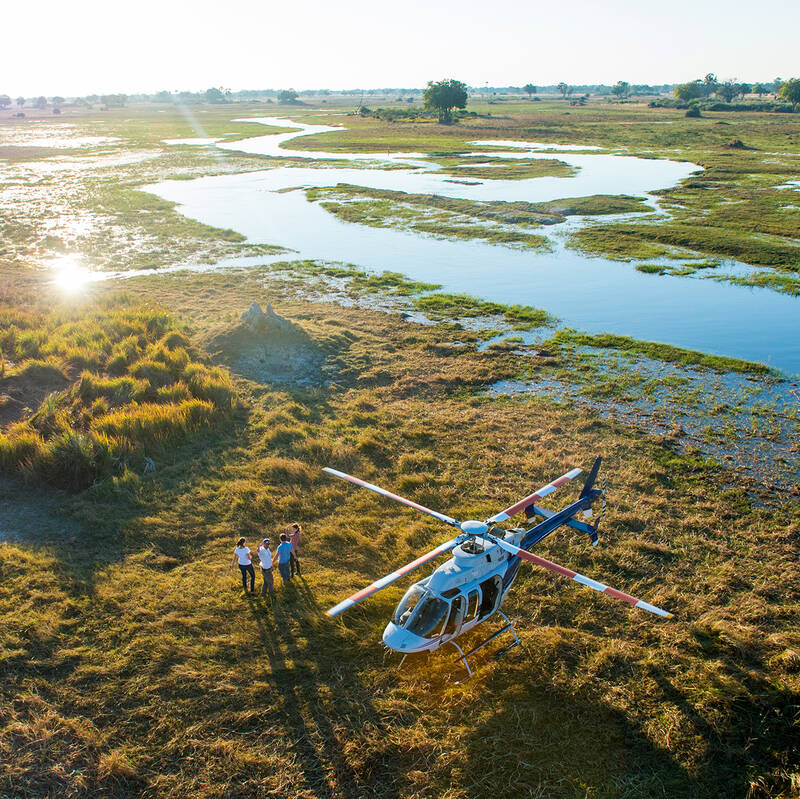
Helicopter Flight - Botswana
Various: from 30 minutes to half a day.
Low-flying, agile and offering superb views, helicopters are an ideal way to move around the Okavango Delta.You can use them instead of fixed-wing inter-lodge transfers or as an addition to other wildlife watching activities, and of course, helicopters can hover to allow that perfect pic, whereas fixed-wings can’t.
More about Helicopter Flight
Looking for inspiration on where to travel next?
Visit our trip chooser to explore your options and find inspiration for your perfect African adventure
Inspire meFrequently Asked Questions
NW Kalahari & Okavango Panhandle - Safari Planning
To help you plan your Expert Africa safari to the North-west Kalahari and Okavango Panhandle, we’ve compiled essential information on how to make the most of this unique and lesser-visited region.
Here, you’ll find answers to frequently asked questions, including the differences between the Okavango Panhandle and Delta, the best locations for birdwatching, and how to experience the region’s rich San culture at Tsodilo Hills.
Discover the top safari activities, from mokoro and boat safaris in the Panhandle’s deep waterways to guided bush walks and horseback safaris in the Kalahari. Find out when to visit for the best fishing, where to see the elusive sitatunga antelope, and which lodges offer the most immersive wilderness experiences.
Whether you're interested in cultural encounters, fishing adventures, or remote walking safaris, our FAQ guide to the North-West Kalahari and Okavango Panhandle will help you plan an authentic and unforgettable Botswana safari.
How do I get to the Okavango Panhandle?
By Air – The Fastest Option
The most efficient way to reach the Panhandle is via charter flight from Maun or Kasane, landing at airstrips near key lodges such as Nxamaseri. A fly-in safari provides breathtaking aerial views of the Okavango River and ensures quick, hassle-free transfers to lodges offering boat safaris, fishing, and cultural excursions.
By Road – For Self-Drive Travellers on a Namibia–Victoria Falls Journey
For those on an overland journey from Namibia, the best access point is via the Mohembo Border Post, just north of Shakawe. From here, travellers can explore the Panhandle before continuing their journey east to Maun, Moremi, or Chobe National Park and onward to Victoria Falls. A 4x4 is required for reaching some of the lodges along the river and is wise for visiting Tsodilo Hills, particularly during the wet season when tracks become muddy. This route is ideal for travellers looking to experience the Okavango’s waterways, Tsodilo Hills’ rock art, and the wildlife of northern Botswana as part of a cross-border safari adventure.
How do I get to the Tsodilo Hills?
- By Air: A bush airstrip at Tsodilo Hills allows for fly-in access, but a vehicle is still required on the ground for transfers and guided hikes. Helicopter day trips from Maun or Okavango Delta lodges provide a spectacular aerial arrival and a seamless way to explore the site.
- Organised Road Travel: Nxamaseri Island Lodge offers fully guided excursions to Tsodilo Hills, including an overnight stay at their sleep-out camp, allowing for sunrise hikes, rock art exploration, and exceptional stargazing.
What types of safari camps and lodges are available?
- Nxamaseri Island Lodge – A water-focused retreat set on a secluded island in the Okavango Panhandle. This intimate lodge specialises in mokoro excursions, fishing, and birdwatching, offering excellent access to deep river channels and papyrus-lined lagoons. It also serves as a base for guided day trips to Tsodilo Hills, combining Delta wilderness with cultural heritage.
- Feline Fields – A luxury desert lodge in the remote North-West Kalahari, offering a completely different safari experience. Here, guests can explore the semi-arid landscapes on horseback, fat bikes, or guided bush walks, with opportunities for cultural interactions with the San people. The lodge’s exclusivity and boutique-style hospitality make it ideal for those seeking seclusion and adventure beyond traditional safaris.
- Tsodilo Hills Sleep-Out Camp – For those wanting to experience Tsodilo Hills in the most immersive way, Nxamaseri Island Lodge operates a sleep-out camp at this UNESCO World Heritage Site. Guests can stay overnight in a simple yet atmospheric camp, allowing for early morning hikes, in-depth exploration of rock art sites, and stargazing in one of the most spiritually significant locations in Africa. Each of these lodges provides a unique, off-the-beaten-track safari, perfect for travellers seeking wilderness, culture, and adventure in Botswana’s most remote landscapes.
Are houseboat safaris available in the Okavango Panhandle?
Expert Africa doesn’t currently arrange houseboat safaris in the Panhandle, instead, we offer exceptional riverboat experiences on the Chobe River, where you can enjoy big-game viewing from the water, luxury accommodations, and guided excursions along the riverfront. Find out more about our Chobe River houseboat safaris.
Can I visit Tsodilo Hills on a day trip, or is it better to stay overnight?
- Day Trips: Helicopter excursions from the Okavango Delta or Maun provide a fast and scenic way to visit Tsodilo Hills in a single day. These trips offer spectacular aerial views and include guided rock art walks before flying back in the afternoon. Alternatively, guests staying at Nxamaseri Island Lodge can take a guided boat and vehicle transfer (approx. 1-1.5hrs) for a full-day cultural excursion.
- Overnight Stay: For a more immersive experience, Nxamaseri Island Lodge operates a simple yet atmospheric Sleep-Out Camp at Tsodilo Hills. This allows guests to experience early morning hikes, sunset views over the sacred hills, and stargazing in one of the most spiritually significant sites in Africa.
What makes the North-west Kalahari different from other parts of the Kalahari?
It is also less developed for tourism, offering an even more remote, unspoiled safari experience. Culturally, the area is significant as home to the Tsodilo Hills, a UNESCO World Heritage Site with thousands of ancient rock paintings, and it remains one of the best places to engage with San communities, learning about their traditional tracking and survival skills.
What’s the best way to combine this area with Chobe or Moremi for a longer safari?
We will always work with you to create a bespoke itinerary, whether luxury fly-in on pan-African road-trip. To understand how we might look at combining these areas, here’s a couple of contrasting ideas:
Fly-In Option: The Fastest & Most Comfortable Way
For a seamless journey, the best way to combine these regions is via light aircraft.
- Start in the Panhandle – Fly from Maun or Kasane to a lodge in the Okavango Panhandle, such as Nxamaseri Island Lodge, where you can enjoy boat safaris, mokoro trips, and fishing.
- Visit Moremi Game Reserve – From the Panhandle, fly into Moremi or a private Delta concession for a classic big-game safari, with lion, leopard, wild dog, and elephant sightings.
- Continue to Chobe – A final flight can take you to Chobe National Park, where you can experience huge elephant herds, predator action, and boat safaris along the Chobe River.
For those on a Namibia–Botswana–Victoria Falls road trip, the Okavango Panhandle fits perfectly into a self-drive itinerary.
- Enter from Namibia via the Mohembo Border Post at the Panhandle’s northern reaches and explore the region before heading back north and across the Caprivi Strip.
- Stop at one of the camp on the Kwando River (like Nambwa, Kazile, Lianshulu or Camp Kwando) and perhaps add a stop into Nkasa Rupara National Park (like Nkaza Lupale).
- Then leave Namibia, crossing the Ngoma Bridge on the Chobe River and stopping for a few nights in Northern Chobe (Maybe at Muchenje, Ngoma Safari Lodge or Chobe Elephan camp) before heading back to Kasane.
- The journey can end with a few days at Victoria Falls or Livingstone, creating a spectacular cross-border safari adventure.
Videos from North-west Kalahari & Panhandle
Watch these videos to learn more about North-west Kalahari & Panhandle
